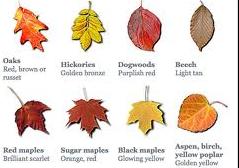
We usually think of leaves as being green in colour. Are they always? Not really. If you observe carefully, you will notice that from the time a leaf is unfolded, to the moment it falls of a branch, it undergoes a change in colouration.
In cold countries, leaves become yellow, brown, orange and red in the passage of seasons. This phenomenon usually happens at the turn of summer and fall or autumn seasons. Why does this happen?
We know that chlorophyll, the green pigment, causes the green colour in leaves. In cold countries, the leaves of trees become busy during summer manufacturing food for the entire tree with the help of chlorophyll.
However, when winter approaches, and days are shorter, food production in the leaves does not happen as often as it used to be. The tree starts using the food that it has stored in its trunk and branches.
In winter, preparing food becomes impossible for leaves and thus plants ‘shut down’ their food factory! As a result, the chlorophyll present in the leaves becomes of no use; it breaks down and disintegrates. Other pigments, such as xanthophyll- yellow in colour, carotin-orange in colour and anthocyanin-red, start appearing on the leaf. These colours were dominated by the green colour so far. When green is weak, the leaves shine in these bright and brilliant colours.
Picture Credit : Google

